
The Brick Works De Panoven is a brick museum in Zevenaar, the Gelderland, the Netherlands. The museum is an Anchor point on the European Route of Industrial Heritage. [1] It is also a rijksmonument (number 338309).

The Brick Works De Panoven is a brick museum in Zevenaar, the Gelderland, the Netherlands. The museum is an Anchor point on the European Route of Industrial Heritage. [1] It is also a rijksmonument (number 338309).
There was a kiln in Zevenaar when it received its charter in 1487 . The region has large natural supplies of clay. Nijmegen had used tiles from Zevenaar since 1583. Brickmakers expanded beyond the borders of the town. De Panoven was set up in 1860; continuing the tradition. It started with a single shaft kiln then expanded embracing new technology. In 1901 De Panoven began supplying the first machine-made roof tiles and bricks and 20 years later the first drying sheds were built. The last innovation was the zigzag kiln erected in 1926. [2] This basically operated like a ring kiln, but could be continually fired, saving on fuel. This kiln is the sole remaining intact model in Western Europe. The business was closed in 1982. [1]
The museum displays clay pits (De Gelderse Poort) with their interesting biotope. There is also the kiln and opportunity to make hand-made bricks using an old Aberson cascade handform press [1]

A brick is a type of block used to build walls, pavements and other elements in masonry construction. Properly, the term brick denotes a block composed of dried clay, but is now also used informally to denote other chemically cured construction blocks. Bricks can be joined using mortar, adhesives or by interlocking them. Bricks are produced in numerous classes, types, materials, and sizes which vary with region and time period, and are produced in bulk quantities.

Porcelain is a ceramic material made by heating substances, generally including a material like kaolin, in a kiln to temperatures between 1,200 and 1,400 °C. The strength, and translucence of porcelain, relative to other types of pottery, arises mainly from vitrification and the formation of the mineral mullite within the body at these high temperatures. Though definitions vary, porcelain can be divided into three main categories: hard-paste, soft-paste and bone china. The category that an object belongs to depends on the composition of the paste used to make the body of the porcelain object and the firing conditions.
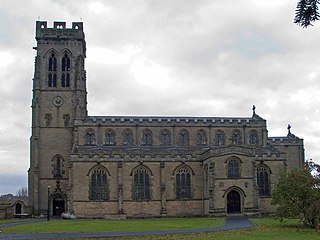
Broseley is a market town in Shropshire, England, with a population of 4,929 at the 2011 Census and an estimate of 5,022 in 2019. The River Severn flows to its north and east. The first iron bridge in the world was built in 1779 across the Severn, linking Broseley with Coalbrookdale and Madeley. This contributed to the early industrial development in the Ironbridge Gorge, which is now part of a World Heritage Site.

Clinker bricks are partially-vitrified bricks used in the construction of buildings.

A brickworks, also known as a brick factory, is a factory for the manufacturing of bricks, from clay or shale. Usually a brickworks is located on a clay bedrock, often with a quarry for clay on site.

Architectural terracotta refers to a fired mixture of clay and water that can be used in a non-structural, semi-structural, or structural capacity on the exterior or interior of a building. Terracotta pottery, as earthenware is called when not used for vessels, is an ancient building material that translates from Latin as "baked earth". Some architectural terracotta is actually the stronger stoneware. It can be unglazed, painted, slip glazed, or glazed. A piece of terracotta is composed of a hollow clay web enclosing a void space or cell. The cell can be installed in compression with mortar or hung with metal anchors. All cells are partially backfilled with mortar.
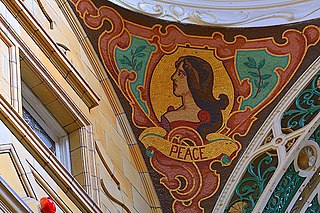
Burmantofts Pottery was the common trading name of a manufacturer of ceramic pipes and construction materials, named after the Burmantofts district of Leeds, England.

The Gladstone Pottery Museum is a working museum of a medium-sized coal-fired pottery, typical of those once common in the North Staffordshire area of England from the time of the industrial revolution in the 18th century to the mid 20th century. It is a grade II* listed building.

The Claybank Brick Plant National Historic Site, located near Claybank, Saskatchewan at the foot of the Dirt Hills in the Rural Municipality of Elmsthorpe No. 100, was an operational brick manufacturing plant from 1914–1989. Bricks manufactured at the site have been used to construct prominent Canadian buildings such as the Bessborough Hotel in Saskatoon and the Chateau Frontenac in Quebec City. The site was designated as a National Historic Site in 1996 and remains one of Canada’s greatest examples of early twentieth century industrialism.
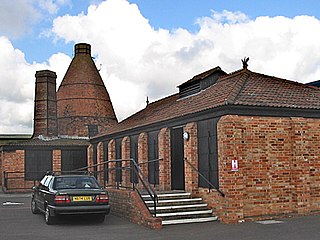
The Somerset Brick and Tile Museum is in Bridgwater, Somerset, England and is administered by The South West Heritage Trust.
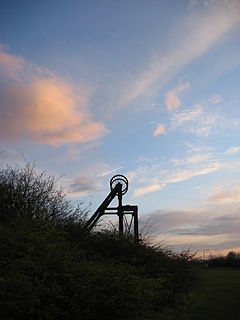
Prestongrange Museum is an industrial heritage museum at Prestongrange between Musselburgh and Prestonpans on the B1348 on the East Lothian coast, Scotland. Founded as the original site of the National Mining Museum, its operation reverted to East Lothian Council Museum Service in 1992.

The Brunswick Brick Tile & Pottery Company was established in 1870 on a 12-acre paddock on Albert Street Brunswick, as one of the first modern mechanical brickworks in Australia. It was also known as the Hoffman Patent Brick & Tile Company, Hoffman Brickworks, or just ' Hoffman's' for most of its 100 plus years of operation.
The south bank of the Humber Estuary in England is a relatively unpopulated area containing large scale industrial development built from the 1950s onward, including national scale petroleum and chemical plants as well as gigawatt scale gas fired power stations.

The Chandos Glass Cone in Bridgwater, in the English county of Somerset, was built in 1725 as a kiln for a glassworks. The remains have been scheduled as an ancient monument.

The Mildenberg Brick Work Park is a visitor attraction and museum in Mildenberg, (Zehdenick) on the Havel in Brandenburg, Germany. The museum is an Anchor point on the European Route of Industrial Heritage.

Ceramic art is art made from ceramic materials, including clay. It may take forms including artistic pottery, including tableware, tiles, figurines and other sculpture. As one of the plastic arts, ceramic art is one of the visual arts. While some ceramics are considered fine art, as pottery or sculpture, most are considered to be decorative, industrial or applied art objects. Ceramics may also be considered artefacts in archaeology. Ceramic art can be made by one person or by a group of people. In a pottery or ceramic factory, a group of people design, manufacture and decorate the art ware. Products from a pottery are sometimes referred to as "art pottery". In a one-person pottery studio, ceramists or potters produce studio pottery.
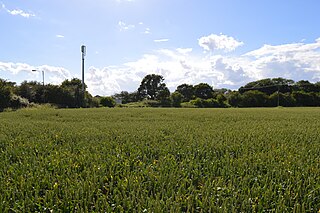
Marks Tey Brickpit is a 29.5 hectare geological Site of Special Scientific Interest in Marks Tey in Essex. It is a Geological Conservation Review site.
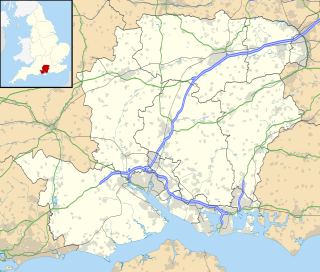
The Brickworks Museum, also known as Bursledon Brickworks, is a volunteer-run museum in Swanwick, Hampshire, England. It is purportedly the UK's sole surviving Victorian steam-driven brickworks.
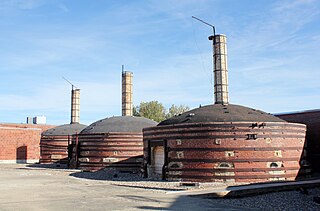
The Medalta Potteries was a Canadian ceramics manufacturing company in Medicine Hat, Alberta, that operated from 1916 to 1954. It was the first manufacturer in Western Canada to ship its products east of Ontario.

The Lithgow Valley Colliery and Pottery Site is a heritage-listed former pottery and colliery and now pottery and visitor attraction at Bent Street, Lithgow, City of Lithgow, New South Wales, Australia. It was built from 1876 to 1945. It is also known as Lithgow Pottery and Brickworks. The property is privately owned. It was added to the New South Wales State Heritage Register on 2 April 1999.
| Wikimedia Commons has media related to Steenfabriek de Panoven . |
Coordinates: 51°55′07″N6°04′02″E / 51.9185°N 6.0673°E